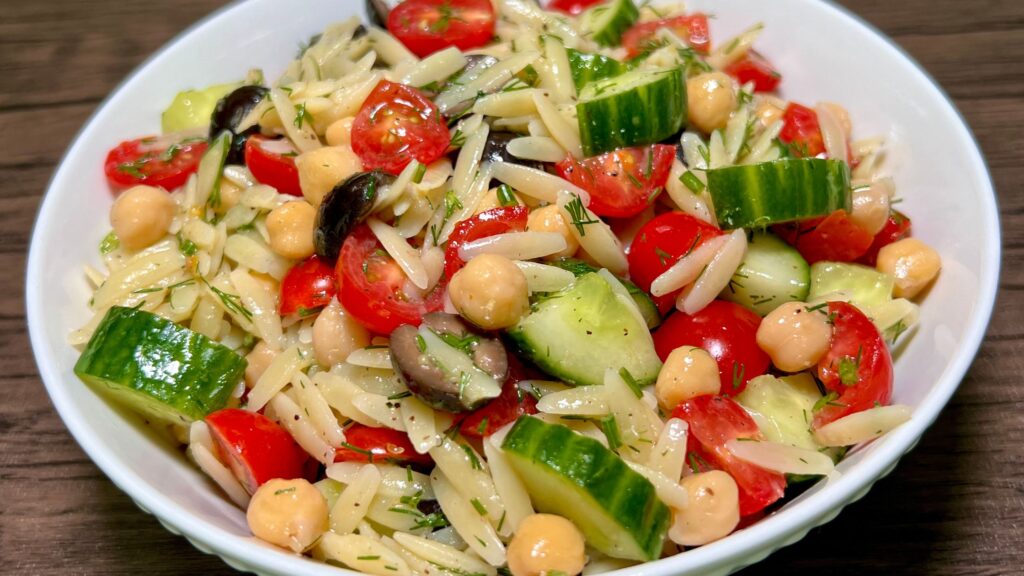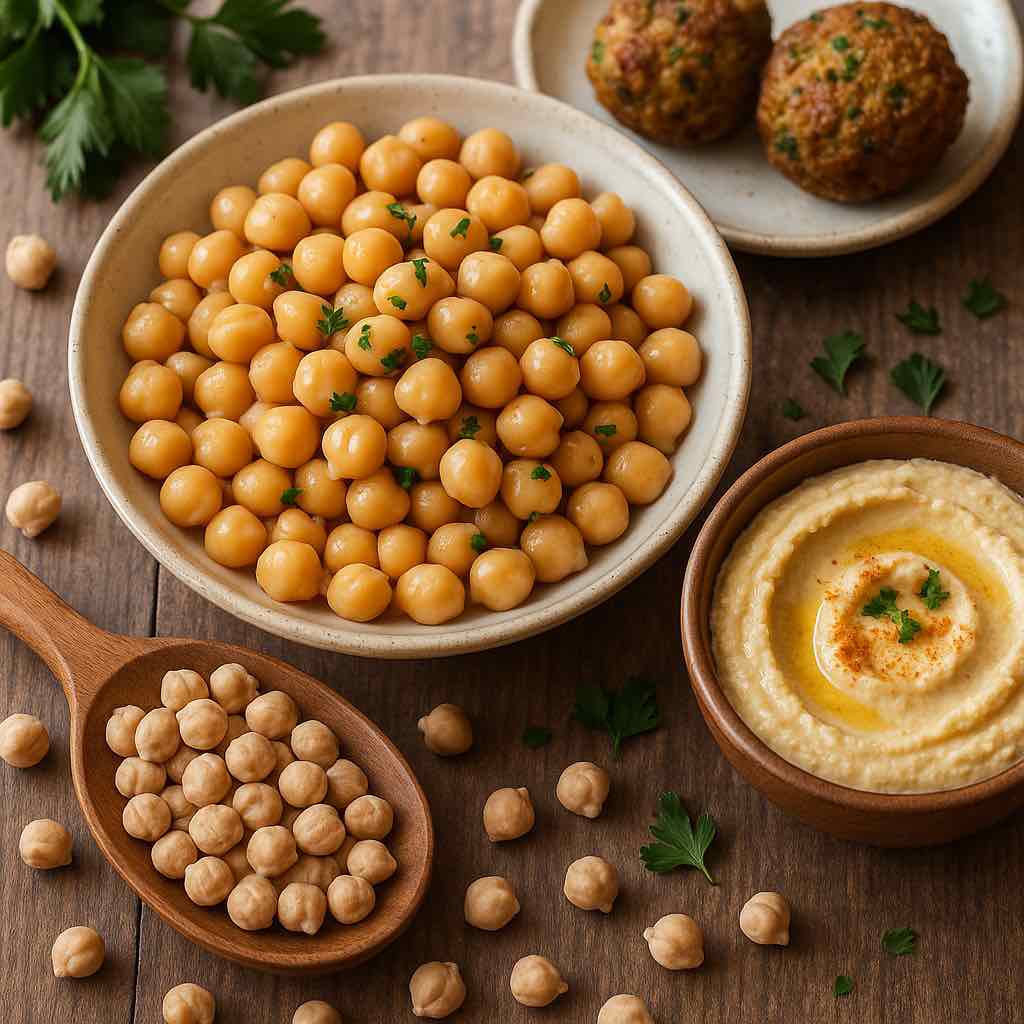This post may contain affiliate links, which means I may receive a commission from purchases made through the links.
When you think of superfoods, your mind might go straight to kale, chia seeds, or blueberries. But tucked away quietly in your pantry, possibly sitting in a can or dry bag, is one of the most underrated nutritional powerhouses of all: the chickpeas. Also known as garbanzo beans, chickpeas are hearty, versatile, delicious, and remarkably good for your health. This is especially true if you are trying to eat more plant proteins or to reduce your cholesterol. In this blog post, we will go over the health benefits of chickpeas, their nutritional value, and several awesome ways to eat them.
Disclaimer: Please note that this article is a result of my personal research and that it is for informational purposes only. For medical advice or diagnosis, consult a professional.
The Nutritional Value of Chickpeas
Don’t let their small size fool you. Chickpeas are bursting with nutrients. One cup of cooked chickpeas (about 164 grams) delivers:
- Protein: ~15 grams
- Fiber: ~12 grams
- Iron: ~4.7 mg (about 26% of your daily need)
- Folate (Vitamin B9): ~282 mcg (71% DV)
- Magnesium, Potassium, and Zinc in healthy amounts
- Low in fat, but rich in complex carbohydrates
Their combination of protein and fiber makes chickpeas a satiating food – they help you feel full longer, stabilize blood sugar, and support digestive health. For vegans, vegetarians, and those who are looking to consume more plant protein, chickpeas are a particularly valuable source of plant-based protein.

The Health Benefits of Chickpeas
1. Heart Health
Chickpeas can help reduce LDL (bad) cholesterol, thanks to their high fiber content. This legume is rich in soluble fiber, a type of fiber that not only facilitates digestion but also binds with cholesterol particles in the digestive system and helps flush them out of the body. This process can significantly reduce levels of bad cholesterol that contribute to artery-clogging plaque. Lower LDL levels mean a lower risk of heart disease and stroke.
Chickpeas are also low in saturated fat. This makes them a heart-smart alternative to meat and other animal proteins, which often contain higher levels of saturated fat and cholesterol, both of which are known contributors to heart disease. Additionally, like many other plant foods, chickpeas contain beneficial compounds like polyphenols and antioxidants that protect the heart. These compounds help combat oxidative stress and inflammation, two key factors in the development of cardiovascular disease. The antioxidants help protect the lining of blood vessels, improve circulation, and prevent the oxidation of cholesterol, which is a major trigger for plaque buildup.
2. Weight Management
Thanks to their ability to promote satiety, chickpeas can help with healthy weight management. Their high protein and dietary fiber content help control appetite and prevent overeating. The fiber slows down digestion, keeping you feeling full for longer and helping to stabilize blood sugar levels, which reduces the likelihood of energy crashes and cravings for unhealthy snacks. Protein, on the other hand, not only contributes to a feeling of fullness but also requires more energy for the body to digest and metabolize, boosting calorie burn slightly through the thermic effect of food.
Additionally, chickpeas have a low glycemic index, meaning they cause a slower, more gradual rise in blood glucose, which can help reduce fat storage triggered by insulin spikes. They’re also relatively low in calories for the amount of volume they provide, making them a satisfying, nutrient-dense food that can help reduce overall calorie intake without leaving you hungry. When used as a substitute for higher-calorie, less nutritious ingredients like fatty meats or refined carbs, chickpeas offer better support for your weight goals.

3. Support for Healthy Blood Pressure
Chickpeas are a source of magnesium and potassium, two minerals that help regulate blood pressure. Magnesium relaxes blood vessels and improves blood flow, while potassium balances sodium levels in the body, helping to keep pressure in check.
4. Blood Sugar Balance
With a low glycemic index, chickpeas cause a slower rise in blood sugar, which is great news for people managing diabetes or insulin resistance. The fiber and protein in them also play a role in keeping energy levels steady.
5. Great for All Ages
Chickpeas contain nutrients and minerals that are great for all ages and especially for particular groups of people, like pregnant women and young children. Folate, for instance, is essential for cell growth and development, making chickpeas a great choice for pregnant individuals. Additionally, they contain iron, which supports energy and focus, particularly important for growing kids and active adults alike.
With all those details covered on what kind of superfood the chickpeas are, you might be wondering at this point, “Well, what are the best ways to enjoy chickpeas, then?” That’s my favorite part to talk about! Let’s get to it.
Ways to Eat Chickpeas
One of chickpeas’ superpowers is their versatility. You can use them in everything from savory dishes to sweet desserts, from salads to stews and soups. The options are endless. Here are some delicious ways to incorporate chickpeas into your meals:
1. Classic Hummus
Who does not love the classic hummus with pita bread and a fresh salad on the side?! You can always grab ready-made hummus from your nearest grocery store, but you can also make it at home. The process is not too complicated. All you need to do is blend cooked chickpeas with tahini, lemon juice, garlic, olive oil, and salt. Add roasted red peppers for a more beautiful finish. Here is a recipe for homemade hummus from one of my favorite cooking blogs – Inspired Taste.
2. Chickpea Stew or Curry
These are super popular in Indian restaurants, often called Chana masala for whole chickpeas, and chana dal for split chickpeas. Chickpeas soak up spices beautifully. To make these curries, they are cooked in a tomato-based sauce with onions, garlic, turmeric, cumin, and other spices. Here’s my favorite chickpea curry, from a YouTube channel.
3. Salad Topper
My favorite way to eat chickpeas right now is by adding them to salads. I mean, it is also summertime! Chickpea salads are so delicious, filling, and nutritious, you won’t stop making them once you get started. You can add chickpeas to salads in two ways: first, as a supporting ingredient (a topper) in the salad, as in the case of my vibrant Orzo pasta salad. You can also add them to grain bowls like quinoa or other types of bean salads for extra texture and protein. They pair so well with greens, cucumbers, feta cheese, and a lemony dressing, all of which are already salad staples.

4. Chickpea Salad
The second way is by using chickpeas as the main ingredient in the salad. The process for making a chickpea salad is super simple and very customizable. Start with a can of rinsed and drained chickpeas or about 1.5 cups of cooked ones. Toss them in a bowl with chopped cucumbers, cherry tomatoes, black olives, red onion, and fresh parsley or dill. Add a sprinkle of feta cheese or diced avocado for extra creaminess. For the dressing, whisk together olive oil, lemon juice, Dijon mustard, garlic, salt, and black pepper. Mix everything and let it sit for 10–15 minutes so the flavors meld. Enjoy!
5. Roasted Chickpeas
Did you know you can also roast chickpeas? Yes, you can! Now, this is not my go-to method for eating them, but in case you are a fan of roasted pulses, I got you covered. Start with a can of chickpeas or ones you’ve boiled at home. Drain and rinse them well, then pat them dry thoroughly with a clean towel. This helps them crisp up in the oven. Toss the chickpeas with a bit of olive oil, salt, and your favorite seasonings. Popular choices include paprika, garlic powder, cumin, chili powder, or even curry powder. Spread them out on a baking sheet in a single layer and roast at 400°F (200°C) for about 25 to 35 minutes, shaking the pan halfway through to ensure even browning. They should be golden and crunchy when done. Let them cool before snacking. You can also use roasted chickpeas as a topping for salads, soups, or grain bowls for extra texture and flavor.

6. Chickpea Patties or “Falafel”
Falafel is a beloved Middle Eastern dish made from ground chickpeas blended with herbs, spices, and aromatics, then formed into balls or patties and typically fried until golden and crispy on the outside. To make traditional falafel, you’ll need to start with dried chickpeas, not canned. The dried chickpeas are soaked overnight but not cooked, which helps the falafel hold together and develop a light, fluffy interior. After soaking, the chickpeas are processed with onion, garlic, fresh parsley or cilantro, cumin, coriander, salt, and a bit of baking soda to add fluffiness. Once the mixture is well combined and slightly coarse, it’s shaped into small balls or patties and fried in hot oil until crispy and fragrant. You can also bake or air-fry them for a lighter version.
Falafel is often served in pita bread with toppings like tahini sauce, hummus, lettuce, tomatoes, cucumbers, and pickles. It’s protein-packed, naturally vegan, and absolutely packed with flavor. It is perfect as a snack, salad topper, or satisfying meat-free meal.
7. Chickpea Pasta
Chickpea pasta is gaining popularity now more than ever! Packed with protein and being gluten-free, it is a fantastic alternative to traditional wheat pasta, especially for those looking to boost their protein and fiber intake or avoid gluten. This pasta is made primarily from chickpea flour, also known as besan, and it typically contains just one or two ingredients, making it a clean, minimally processed choice. We’ve already talked about the nutritional profile of chickpeas, so obviously, chickpea pasta packs a punch: a typical serving of it has about 13–15 grams of protein and 5–8 grams of fiber, significantly more than regular pasta, which helps keep you full longer and supports stable blood sugar levels.
Cooking chickpea pasta is just as easy as the classic version of pasta – boil it in salted water until tender (usually 7–9 minutes), but watch it closely as it can overcook slightly faster. It has a slightly nutty flavor and a firm texture that pairs well with all kinds of sauces, from hearty tomato or pesto to lighter lemon-garlic olive oil blends. You can also toss it into pasta salads, veggie bowls, or stir-fries for a quick and nutritious meal. Chickpea pasta is, without doubt, a smart way to upgrade your plate.
8. Chickpea Flour
Also known as gram flour, besan, or garbanzo bean flour, chickpea flour is a gluten-free, protein-rich flour made by grinding dried chickpeas. It’s a staple in Indian, Middle Eastern, and Mediterranean cooking, prized for its nutty flavor, dense texture, and impressive nutritional profile. One cup of chickpea flour contains around 20 grams of protein, 10 grams of fiber, and plenty of iron, folate, magnesium, and zinc, making it a powerhouse ingredient for both sweet and savory dishes. We’ve already seen that it is the main ingredient for chickpea pasta, but its use does not end there.
In the kitchen, chickpea flour is incredibly versatile. In Indian cuisine, it’s used to make pakoras (vegetable fritters), socca (a flatbread from southern France), and chilla (a savory pancake). It’s also great as a thickener for soups and sauces or a binder in veggie burgers and meatballs. Vegans also love it as an egg substitute in recipes like omelets, scrambles, or baking. It is mixed with water to form a batter-like consistency for these uses. Because of its absorbent nature and slightly earthy taste, chickpea flour works well in recipes that need structure, moisture, and a nutritional boost.
8. Chickpea Desserts
How about desserts that come with protein and fiber? Believe it or not, you can make sweet-tasting chickpea desserts like this chickpea chocolate chip cookie dough. It might sound unconventional, but it’s a surprisingly delicious and nutritious twist on the classic treat of cookie dough. It is safe to eat raw and is packed with nutrients. The base of this dessert is made by blending cooked chickpeas with ingredients like peanut butter or almond butter, maple syrup or honey, a splash of vanilla extract, and a pinch of salt. The result is a creamy, sweet, cookie-dough-like mixture with a subtle nuttiness and no strong “bean” flavor, especially when balanced with a generous handful of chocolate chips.
This chickpea dessert is completely egg-free, dairy-free, and gluten-free, making it a great option for people with dietary restrictions or anyone looking for a healthier dessert. You can eat it straight from the bowl, use it as a dip for apple slices or pretzels, or roll it into little energy bites for snacking on the go. It’s also customizable, and you can add a bit of cinnamon, oats, shredded coconut, or even espresso powder for different flavors. Chickpea cookie dough proves that indulgence and nutrition really can go hand in hand.
Finally… Chickpeas Are Good for the Planet
Chickpeas are not just good for you; beyond the health benefits of chickpeas, they’re also kind to Mother Earth. As a legume, they enrich the soil with nitrogen, reducing the need for synthetic fertilizers. Also, they require relatively little water compared to animal protein sources, making them a more sustainable food choice, as I further discuss in this article on the benefits of plant-based proteins to our health and the environment.
Conclusion
Chickpeas are the real deal. If you are someone who wants to eat healthier without spending a fortune, chickpeas deserve a regular spot in your diet. They’re budget-friendly, shelf-stable, and endlessly adaptable. From hearty stews and curries to salads, crisped-up snacks, and creamy dips, these little legumes can do it all. So, if you currently have a can of chickpeas or a bag of dried ones in your pantry, go dig them up and get prepping! If you don’t have any, make sure to grab some in your next grocery trip. The possibilities are as limitless with these precious beans.
Got a favorite chickpea recipe or trick you’d like to share with me and the other readers? Please post it in the comments! Let’s keep sharing these healthy dishes with one another.






